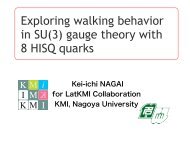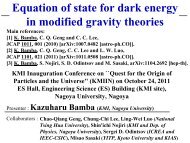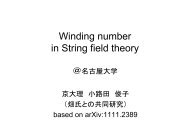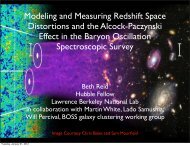Diego Saez-Gomez
Diego Saez-Gomez
Diego Saez-Gomez
Create successful ePaper yourself
Turn your PDF publications into a flip-book with our unique Google optimized e-Paper software.
tudy bations of the are kept quasi-static [13, 15]. approximation Let us point out for II. that this Θ f(R,<br />
F(R,T)<br />
µν<br />
kind this = T −2T ) approximation of GRAVITY models.<br />
gravity<br />
µν − pg µν<br />
InTHEORIES<br />
Section . may VI we apply our results to two particu (7<br />
tion odelsof and thenumerical first-order results perturbed are obtained fields [16, and23] compared and therefore with the requires ΛCDM model. Finally in Section VII we conclu<br />
us iththe Let theequations us main start conclusions bymotion writingbecome<br />
of the this general investigation. action for f(R, T ) gravities [4],<br />
on II, we briefly review the state-of-the-art of f(R, T<br />
S =<br />
II.<br />
S G +<br />
f(R,<br />
S m T<br />
= 1 ) gravity. <br />
) GRAVITY 2κ 2 d 4 x √ Section<br />
osmological equations f R R for µν f(R, − 1 2 fg T )=f µν − (g 1 (R) µν +f −∇ 2 (T µ ∇) ν models ) f R = − as<br />
THEORIES<br />
−g κwell 2 <br />
−(f(R, fas<br />
T Tµν T )+L + f Tm pg ) µν , . (8<br />
omentum conservation for such models. Then, Section IV addressed I. FORMULAE<br />
ons ere we<br />
where,<br />
for have f(R,<br />
Let us Action, κstart 2 dropped<br />
=8πG,<br />
T )=f 1<br />
by writing R<br />
(R)+f the explicit<br />
is the 2 (T<br />
general Ricci<br />
) models dependences<br />
scalar<br />
while of<br />
actionand forT Section f in R<br />
f(R, represents<br />
Vand deals T .<br />
T ) gravities the<br />
with<br />
trace<br />
the<br />
[4], of the energy-momentum tensor, i.e., T =<br />
tis is<br />
while<br />
kind straightforward<br />
L<br />
of models.<br />
m is the matter<br />
Into Section see that<br />
Lagrangian.<br />
VI we theapply usual<br />
As usual<br />
our continuity<br />
the<br />
results<br />
energy-momentum<br />
toequation two particular is not satisfied for the field equations (8), an<br />
S = S c 1 (R/R HS ) n<br />
f(R) =R − R HS<br />
c 2 (R/R HS ) n +1 , f(R) =R + Rn (aR n G + S m = 1 <br />
tensor is defined as,<br />
dsequently comparedthe with covariant the ΛCDM derivative model. ofFinally the energy-momentum in Section VII we<br />
− b)<br />
2κ 2 d 4 x √ tensor conclude is not null in general ∇ µ T µν = 0. In order t<br />
n. ain the modified continuity equation, let us take the covariant−g (f(R, T )+L m ) ,<br />
T 1+cR n .<br />
µν = 2 δS derivative m<br />
√ −g δg µν .<br />
of the equation (8),<br />
<br />
here, κ<br />
Field 2 =8πG, R∇ is µ the f Ricci scalar and T represents the trace of the energy-momentum tensor, i.e., T = T<br />
equations, R R µν − 1 (R, <br />
S EH = d 4 x √ −g <br />
hile Then, T ) GRAVITY<br />
L m<br />
byis varying the matter the THEORIES action Lagrangian. with2respect fg µν − (g µν −∇ µ ∇ ν ) f R = − <br />
κ 2 <br />
+ f T Tµν − f T Θ µν<br />
As usual to the energy-momentum metric field g µν , the tensor<br />
R +2κ 2 field is equations defined as, are obtained,<br />
L m → S = d 4 x √ −g f(R)+2κ 2 <br />
L m<br />
or f(R, T ) fgravities T µν = √ 2<br />
R (R, T )R[4],<br />
µν − 1 δS m<br />
2 f(R, T )g µν − (g µν −∇ µ ∇ ν ) f R (R, T )=− <br />
−g δg µν . κ 2 + f T (R, T ) T µν − f T (R, T )Θ µν ,<br />
where the energy-momentum tensor is defined as: T µν (m) = −√ 2 δ ( √ where = 1 →<br />
the subscripts on the function f(R, T ) mean differentiation −gL m )<br />
hen, by varying the action with respect to the metric field g µν with respect to R or T , and the tensor Θ<br />
2κ , the field equations −g δg µν are obtained,<br />
defined 2 d 4 x √ f R ∇ µ R µν + R µν ∇ µ f R − 1 2 g µν(f R ∇ µ R + f T ∇ µ T ) − (g µν ∇ µ −∇ µ ∇ µ ∇ ν ) f R =<br />
−g (f(R, T )+L m ) , (1)<br />
as,<br />
f R (R, T )R µν − 1 ∇ µ − κ 2 <br />
+ f<br />
T represents the trace of<br />
Divergence of the field 2 f(R, the energy-momentum T )g µν − (g µν −∇ µ ∇ ν ) f R (R, )=− κ 2 + f T (R, T ) T µν − f T (R, T )Θ µν ,<br />
equations Θ µν ≡ g αβ δT tensor, T Tµν − f<br />
i.e., T T Θ<br />
= µν . (9<br />
T µ µ,<br />
αβ<br />
δg µν = −2T µν g µν L m +2g αβ δL m<br />
the energy-momentum tensor is defined as,<br />
us, using the identities ∇ µ R<br />
.<br />
µν − 1 2 Rg µν<br />
= 0, and (∇ν − ∇ ν ) f R (R, T )=R δg µν g µν αβ<br />
∇ µ f R , the covariant derivativ<br />
the here energy-momentum the subscripts on the function f(R, T ) mean differentiation with respect to R or T , and the tensor Θ µν<br />
efined Note T µν that as, = √for 2 δS m<br />
tensor needs to satisfy,<br />
a regular . f(R, T ) function, in absence of any kind of matter, (2) the corresponding f(R) gravity equa<br />
−g δg<br />
µν<br />
are recovered, and consequently<br />
∇ µ T<br />
the corresponding properties and the well-known solutions for f(R) gravity are<br />
µν =<br />
f <br />
T 1<br />
he satisfied metric by fieldf(R, g µν T , the ) theories field equations inκclassical Θ 2 + f<br />
µν ≡ gare αβ δT T 2vacuum g µν∇ µ T − (T µν + Θ µν )∇ µ ln f T −∇ µ Θ<br />
obtained, αβ<br />
δg µν = −2T (for a review on f(R)<br />
µν − g µν L m +2g αβ theories, δL µν . (10<br />
m see [1]). Moreover, here w<br />
.<br />
interested to study the behavior of this kind of theories for spatially flatδg FLRW µν g αβ spacetimes, which are express<br />
nce, comoving for coordinates by the line element,<br />
−∇<br />
In<br />
a<br />
ote that µ ∇<br />
general,<br />
perfect<br />
ν ) f<br />
for R (R,<br />
the<br />
fluid<br />
T )=−<br />
divergence<br />
with an<br />
κ<br />
a regular f(R, 2 +<br />
of<br />
equation<br />
f<br />
the<br />
T ) function, T (R,<br />
equations<br />
T ) of state<br />
T<br />
in µν −<br />
is not<br />
p<br />
f<br />
absence T (R,<br />
null,<br />
= wρ,<br />
T<br />
which<br />
beingw<br />
)Θ<br />
of any kind µν<br />
of matter, the corresponding f(R) gravity equati<br />
re recovered, and consequently the corresponding ds 2 properties = a 2 (η) ,<br />
may give<br />
a constant,<br />
(3)<br />
rise to an<br />
the<br />
anomalous<br />
0−component<br />
behavior<br />
of<br />
of the<br />
the covarian<br />
ivative matter (10) turns content. out to become,<br />
<br />
dη and 2 −the dxwell-known 2 solutions for f(R) gravity are a<br />
atisfied ) mean by differentiation f(R, T ) theories with respect in classical to Rvacuum or T , and (for the a review tensoron Θ µν f(R) is<br />
κ 2 + w − 3<br />
<br />
<br />
f theories, see [1]). Moreover, here we<br />
terested where a(η) to study is the the scale behavior factor T − (1 + w)Tf<br />
2 in of conformal TT T ˙ + 3(1 + w)<br />
H(κ 2 − f<br />
this kind of time theories η. Then, for spatially the main T ) − 2f<br />
flatissue TR (4HḢ FLRW arises spacetimes, on + the Ḧ) T =0. (11<br />
T. Harko, F. S. N. Lobo, S. Nojiri and S. D. Odintsov, content #Phys. which Rev. D84, are of 024020 the expressed<br />
(2011) Unive










